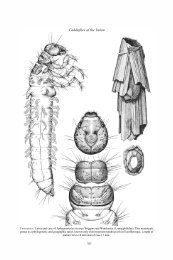PDF 29.6 MB - Department of Biological Sciences
PDF 29.6 MB - Department of Biological Sciences
PDF 29.6 MB - Department of Biological Sciences
Create successful ePaper yourself
Turn your PDF publications into a flip-book with our unique Google optimized e-Paper software.
Canadian Journal <strong>of</strong> Arthropod Identification No. 15 (May 2011) JACKSON ET AL.<br />
The Utility <strong>of</strong> DNA Barcoding for Specimen<br />
Identification in Tephritidae<br />
COI sequences (DNA Barcodes) were<br />
obtained for 128 specimens (out <strong>of</strong> 202 specimens<br />
attempted, see Appendix I), representing 41<br />
species in 22 genera. Of these 128 successful<br />
specimens, 44 yielded full DNA Barcodes (658bp),<br />
59 yielded near-complete DNA Barcodes (561bp<br />
or more), and 25 specimens yielded sequences <strong>of</strong><br />
less than 350bp.<br />
When sequences were compared using a<br />
neighbor-joining phenogram (Appendix II), most,<br />
but not all, specimens formed distinct clusters<br />
which accurately reflected morphological species.<br />
Two clusters incorrectly “identified”<br />
morphologically distinct specimens. Euaresta<br />
festiva (TEPH012, TEPH098) clustered with a<br />
single Euaresta aequalis specimen (TEPH010) and<br />
a single Euphranta canadensis specimen<br />
(TEPH014), despite remaining disjunct from the<br />
main Euaresta aequalis and Euphranta canadensis<br />
clusters. All sequences in this Euaresta festiva<br />
cluster were longer than 601bp, so we postulate a<br />
possible contamination <strong>of</strong> the TEPH010 and<br />
TEPH014 sequences.<br />
A single Rhagoletis cingulata specimen<br />
(TEPH 123) was clustered with Campiglossa<br />
sabroskyi (TEPH0117), while the remaining R.<br />
cingulata specimens successfully clustered<br />
together away from the Campiglossa group. This<br />
anomaly is possibly an artifact <strong>of</strong> insufficient data,<br />
as the TEPH123 sequence is only 288bp, or<br />
perhaps a contaminant.<br />
The sequences identified above as potential<br />
cases <strong>of</strong> contamination were annotated in the<br />
BOLD database to reflect these concerns.<br />
In multiple instances, DNA barcodes <strong>of</strong><br />
closely related species provided insufficient<br />
information for distinguishing between these<br />
species (i.e. Tephritis candidipennis and T. pura;<br />
Eutreta frontalis and E. novaeboracensis;<br />
Urophora affinis and U. cardui). Further taxon<br />
sampling and inclusion <strong>of</strong> more specimens may be<br />
required for differentiating these species using<br />
DNA Barcodes or use <strong>of</strong> another marker may be<br />
necessary.<br />
The objective <strong>of</strong> the sequencing component<br />
<strong>of</strong> this project was to contribute to the DNA<br />
Barcoding database by providing CO1 sequences<br />
based on morphologically identified specimens.<br />
This was done to facilitate the potential use <strong>of</strong> a<br />
sequence database as an identification aid, and not<br />
to test species concepts and taxon limits. With this<br />
in mind, our limited dataset does show that most<br />
genera and species <strong>of</strong> Ontario Tephritidae possess<br />
distinct DNA Barcode clusters, and that most<br />
haplogroups reflect morphologically defined taxa.<br />
The database <strong>of</strong> fruit fly DNA Barcodes is<br />
currently being expanded through an international<br />
collaboration <strong>of</strong> researchers under the Tephritid<br />
Barcode Initiative.<br />
doi:10.3752/cjai.2011.15 4
















